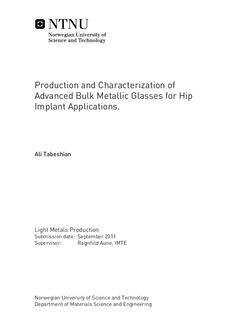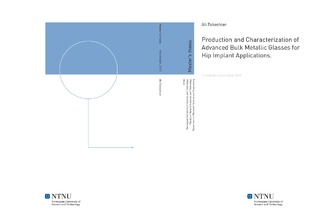| dc.description.abstract | AbstractThe aim of the present project was to investigate the possibilities of using a Zr55Cu30Ni5Al10 Bulk Metallic Glass (BMG) alloy as articulating surface in an artificial hip joint.In order for a material to be used in human body as an implant, the foremost requirement is the acceptability by the human body. The implantations should not cause diseases or other complications for the patients. Moreover, the biomaterials should possess sufficient mechanical strength, high corrosion and wear resistance in harsh body environment with varying loading conditions.There have been extensive research on the properties of stainless steel, Co-Cr-Mo alloys and Ti alloys regarding their bio-compatibility and they are currently being used as orthopedic implants, however less information is available for bulk metallic glasses. So, understanding the corrosion properties of BMGs is one of the key issues to evaluate their potential as biomaterials.In the first phase of the project there was an attempt to develop a Zr-based BMG from pure elements in a vertical resistance furnace and quenching in liquid nitrogen. Afterwards, samples were examined by X-Ray diffraction and microscopically to investigate the presence of crystalline phases. The second phase was electrochemical measurements to study the passivation behavior and the susceptibility to pitting corrosion for the crystalline Zr55Cu30Ni5Al10, amorphous Zr55Cu30Ni5Al10 BMG (received from Japan) and comparing the result with stainless steel and Co-Cr-Mo (F75). Investigations on corrosion properties were made in phosphate-buffered saline (PBS) with and without the addition of albumin fraction V, at a room temperature of 20 °C and body temperature (37°C) and in different pH values of 7.4 and 5.2. Running the experiment in lower pH shows the behavior of the implant against any probable inflation in the patient body.The last phase was to investigate the interaction between the protein and surface of materials. For this purpose, FTIR spectroscopy and Electrochemical Impedance Spectroscopy (EIS) were carried out.Keys words: Biomaterials, Bulk Metallic Glass, Crystalline Zr55Cu30Ni5Al10, Co-Cr-Mo alloy, Stainless steel, Polarization curve, FTIR, Impedance. | nb_NO |

